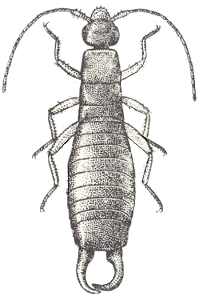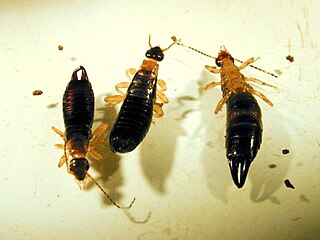
Earwigs make up the insect order Dermaptera. With about 2,000 species in 12 families, they are one of the smaller insect orders. Earwigs have characteristic cerci, a pair of forcep-like pincers on their abdomen, and membranous wings folded underneath short, rarely used forewings, hence the scientific order name, "skin wings". Some groups are tiny parasites on mammals and lack the typical pincers. Earwigs are found on all continents except Antarctica.

Nirmala Srivastava, also known as Shri Mataji Nirmala Devi, was the founder and guru of Sahaja Yoga, a new religious movement. She claimed to have been born fully realised and spent her life working for peace by developing and promoting a simple technique through which people can achieve their self-realization.

Tarentola mauritanica, known as the common wall gecko, is a species of gecko (Gekkota) native to the western Mediterranean area of North Africa and Europe. It has been introduced to Madeira and Balearic Islands, and the Americas. A nocturnal animal with a predominantly insectivorous diet, it is commonly observed on walls in urban environments in warm coastal areas; it can be found further inland, especially in Spain where it has a tradition of cohabitation with humans as an insect hunter. A robust species, up to 15 centimetres (5.9 in) long, its tubercules are enlarged and give the species a spiny armoured appearance.

West Champaran is an administrative district in the state of Bihar in India, located just 60 km (37 mi) west of Birgunj. It is the largest district in Bihar with an area of 5,228 km2(2,019sq mi). It is a part of Tirhut Division. The district headquarters are located in Bettiah. The district is known for its open border with Nepal. One of the major location in West Champaran is Kumar Bagh for SAIL Special Processing Unit and Bhitiharwa where Mahatma Gandhi started Satyagrah Aandolan.

Sacred groves of India are forest fragments of varying sizes, which are communally protected, and which usually have a significant religious connotation for the protecting community. Hunting and logging are usually strictly prohibited within these patches. Other forms of forest usage like honey collection and deadwood collection are sometimes allowed on a sustainable basis. NGOs work with local villagers to protect such groves. Traditionally, and in some cases even today, members of the community take turns to protect the grove. The introduction of the protected area category community reserves under the Wild Life (Protection) Amendment Act, 2002 has introduced legislation for providing government protection to community held lands, which could include sacred groves.

Anisolabis is a genus of mostly Asian earwigs in the subfamily Anisolabidinae. It was cited by Srivastava in Part 2 of Fauna of India. The name Anisolabis stems from the asymmetry of the male cerci; the right cercus being more acute than the left.
Antisolabis is a genus of earwigs, the sole member of the subfamily Antisolabiinae. It was cited by Srivastava in Part 2 of Fauna of India. It was also cited at an earlier date by Steinmann in his publication, The Animal Kingdom in 1986, 1989, 1990, and 1993.
Epilandex is a genus of earwigs in the subfamily Anisolabidinae. It was cited by Srivastava in Part 2 of Fauna of India.

Euborellia is a genus of earwigs in the subfamily Anisolabidinae. This genus, which has a world-wide distribution, was erected by Malcolm Burr in 1909 and was cited by Srivastava in Part 2 of Fauna of India.

Gonolabis is a genus of earwigs in the subfamily Anisolabidinae. It was cited by Srivastava in Part 2 of Fauna of India.
Mongolabis is a genus of earwigs in the subfamily Anisolabidinae. It was cited by Srivastava in Part 2 of Fauna of India.
Placolabis is a genus of earwigs in the subfamily Anisolabidinae. It was cited by Srivastava in Part 2 of Fauna of India.
Platylabia is a genus of earwigs, the sole member of the subfamily Platylabiinae. It was cited by Srivastava in Part 2 of Fauna of India. It was also cited at an earlier date by Steinmann in his publication, The Animal Kingdom in 1986, 1989, 1990, and 1993, and by Chen & Ma in Fauna Sinica in 2004.
Aborolabis mauritanica is a species of earwig in the genus Aborolabis, the family Anisolabididae, and the order Dermaptera. Found primarily in the Palearctic realm, but also in parts of the Afrotropical realm, this species was discovered by Hippolyte Lucas in 1846.
Aborolabis mordax is a species of earwig in the genus Aborolabis, the family Anisolabididae, and the order Dermaptera. Found primarily in the Palearctic realm, this species was first classified by Henrik Steinmann in 1978.
Aborolabis cerrobarjai is a species of earwig in the genus Aborolabis, the family Anisolabididae, and the order Dermaptera.
Aborolabis angulifera is a species of earwig in the genus Aborolabis, the family Anisolabididae, and the order Dermaptera. Primarily found in the Afrotropical realm, this species was discovered by Dohrn in 1864.
Aborolabis martensi is a species of earwig in the genus Aborolabis, the family Anisolabididae, and the order Dermaptera.
Aborolabis pervicina is a species of earwig in the genus Aborolabis, the family Anisolabididae, and the order Dermaptera. Found primarily in the Indomalayan realm, this species was first classified by Burr in 1913.
Aborolabis tanzanica is a species of earwig in the genus Aborolabis, the family Anisolabididae, and the order Dermaptera.







